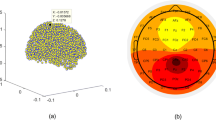Abstract
This work deals with elimination artifacts from electroencephalograms (EEGs). Though many methods for solving the problem have been proposed, they either require direct intervention of the researcher, are based on additional measurements (electrooculogram, electrocardiogram, etc.), or cannot remove artifact activity to a sufficient extent. We proposed an automated method that uses of the fact that the electromyogram (EMG) is not correlated and the artifacts of electrode movement at adjacent derivations and is based on the representation of electrical activity in one derivation through activity in other derivations. The analysis of the proposed method using model signals and examples of real EEG recordings has demonstrated its practical effectiveness.
Similar content being viewed by others
References
Ille, N., Berg, P., and Scherg, M., Artifact Correction of the Ongoing EEG Using Spatial Filters Based on Artifact and Brain Signal Topographies, J. Clin. Neurophysiol., 2002, vol. 19, no. 2, p. 113.
Schlögl, A., Keinrath., C., Zimmermann, D., et al., A Fully Automated Correction Method of EOG Artifacts in EEG Recordings, Clin. Neurophysiol., 2007, vol. 118, no. 1, p. 98.
Erfanian, A., and Mahmoudi., B., Real-Time Ocular Artifact Suppression Using Recurrent N Neural Network for Electro-Encephalogram Based Brain Computer Interface, Med. Biol. Eng. Comput., 2005, vol. 43, no. 2, p. 296.
Jiang, J.A., Chao, C.F., Chiu M.J., et al., An Automatic Analysis Method for Detecting and Eliminating ECG Artifacts in EEG, Comput. Biol. Med., 2007, vol. 37, no. 11, p. 1660.
James, C.J., and Hesse, C.W., Independent Component Analysis for Biomedical Signals, Physiol. Meas., 2005, vol. 26, no. 1, p. 15.
Vigário, R., Särelä, J., Jousmäki, V., et al., Independent Component Approach to the Analysis of EEG and MEG Recordings, IEEE Trans. Biomed. Eng., 2000, vol. 47, no. 5, p. 589.
Castellanos, N.P., and Makarov, V.A., Recovering EEG Brain Signals: Artifact Suppression with Wavelet Enhanced Independent Component Analysis, J. Neurosci. Methods, 2006, vol. 158, no. 2, p. 300.
James, C.J., and Gibson, O.J., Temporary Constrained ICA: An Application to Artifact Rejection in Electromagnetic Brain Signal Analysis, IEEE Trans. Biomed. Eng., 2003, vol. 50, no. 9, p. 1108.
Ghanderson, H., and Erfman., A., A Fully Automatic Method for Ocular Artifact Suppression from EEG Data Using Wavelet Transform and Independent Component Analysis, Conf. Proc. IEEE Eng. Med. Biol. Soc., 2006, no. 1, p. 5265.
Le Van, P., Urrestarazu, E., and Gotman, J., A System for Automatic Artifact Removal in Ictal Scalp EEG Based on Independent Component Analysis and Bayesian Classification, Clin. Neurophysiol., 2006, vol. 117, no. 4, p. 912.
Buchthal, F., and Madsen, A., Synchronous Activity in Normal and Atrophic Muscle, EEG Clin. Neurophysiol., 1950, vol. 2, no. 4, p. 425.
Ivanov, L.B., and Shaligin, V.S., Raspoznavanie artefaktov i nekotorie slozhnosti prakticheskogo analiza komp’iuternoi EEG (Artifact Recognition and Some Difficulties in Practical Analysis of Computer EEG), Moscow: MBN, 2007.
Seber, J.A.F., Linear Regression Analysis, John Wiley and Sons, 1977.
Bell, A.J. and Sejnowski, T.J., An Informational Maximization Approach to Blind Separation and Blind Deconvolution, Neur. Comput., 1995, no. 7, p. 1129.
Makeig, S., Bell, A.J., Jung, T.-P., and Sejnowsky, T.J., Independent Component Analysis of Electroencephalographic Data, in Advances in Neural Information Processing Systems, Tourezky, D., Mozer, M., and Hasselmo, M., Eds, Cambridge: MIT Press, 1996, vol. 8, p. 145.
Makeig, S., EEGlab: ICA Toolbox for Physiological Research, www Site, Swartz Center for Computational Neuroscience, Institute of Neural Computation, University of San Diego California 〈www.sccn.ucsd.edu/ eeglab/〉, 2000 [World Wide Web Publication].
Author information
Authors and Affiliations
Additional information
Original Russian Text © E.L. Masherov, P.E. Volynsky, G.A. Shekut’ev, 2009, published in Fiziologiya Cheloveka, 2009, Vol. 35, No. 4, pp. 124–134.
Rights and permissions
About this article
Cite this article
Masherov, E.L., Volynsky, P.E. & Shekut’ev, G.A. An approach to removing spatially uncorrelated artifacts from EEG recordings. Hum Physiol 35, 502–512 (2009). https://doi.org/10.1134/S0362119709040161
Received:
Published:
Issue Date:
DOI: https://doi.org/10.1134/S0362119709040161




